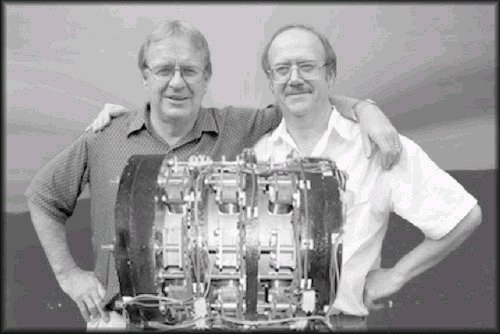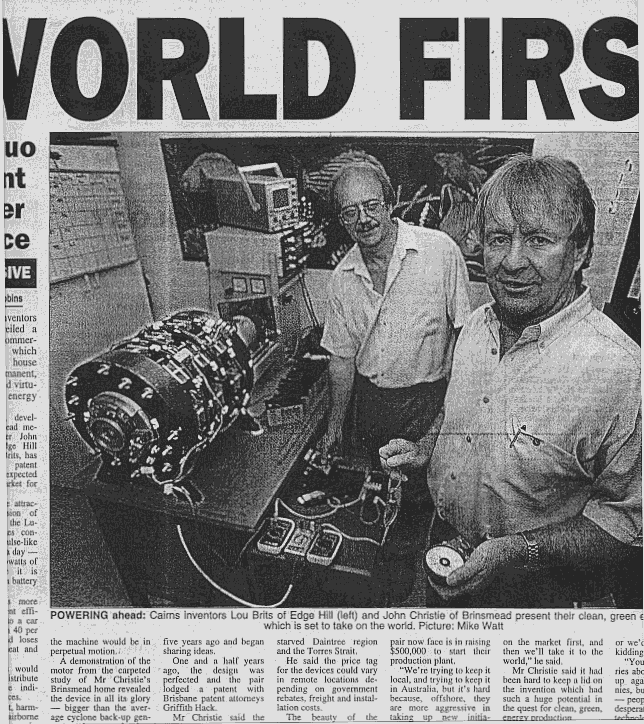Can Power Home From Near
Free Energy Source
The Cairns Post - Northern Queensland, OZ
3-8-1



Mr Christie said he and Brits had received offers from prospective investors and buyers "all over the globe", including Europe and the USA. One offer came from an agent acting on behalf of the U.S. Military, who wanted to purchase 500 of the generators with a view to ongoing orders. But while both men welcomed such offers, Christie said that those who wish to exercise their due diligence in examining the device would need to come to them. About 20 of the offers resulted in visits, some of them engineers. Brits said all of them were impressed.
When asked about patenting of the machine, Brits said the entire process consumed about two-and-a-half years, with the provisional application taking about 18 months. He said the required preliminary examination was passed with "flying colours".
The men hesitated for about two of the six years taken to develop the Lutec 1000, due to all the "horror stories" they heard about "oil companies, KGB, CIA..." involved in burying similar types of inventions. It was for this reason that news of the technology was released in the fashion that they chose. Christie explained that even if anything were to happen to them, it would be too late, since the invention is now in the public domain and listed with the Patents Office. News of the generator has reached many countries including India, Pakistan, England and European nations.
Another delay factor involved money. Brits said the work involved in developing the machine costed them "a couple of million bucks".
Sightings progam host Jeff Rense highlighted that a current key issue facing the future of the Lutec 1000 would be how its development could be interfaced with mega-trillion-dollar companies that traditionally depend on fossil fuels for their revenue.
During early March, local FNQ media published announcement of the generator, which relies on repulsion and attraction of internal magnets to generate 24 kilowatts of continuous power after being kick-started from a battery. The duo presented their invention to the world as a clean and almost free-energy source of both domestic and commercial power, citing 500% efficiency. Later during the same week, a caution was publicized in the Cairns Post from James Cook University physicist Ron White, who urged prospective investors to "be sure they are very comfortable with all the technical details before making any commitment". He offered to test the device at JCU's Townsville campus, but Brits and Christie refuse to transport their generator, instead welcoming engineers who wanted to bring their own equipment and conduct their own tests.
After news of the invention was released, Brits and Christie were swamped
with visits, telephone enquiries, offers and orders. One local businessman
offered to fund establishment of a production plant in Far North Queensland.
Christie and Brits were quoted in the Cairns Post as being keen to set
up a production plant in Cairns to supply remote areas in Queensland, as well
as possibly selling excess power to Ergon Energy.
However, during the Sightings
interview, Mr Brits said they had no intention to build and supply the
generator in Australia. Instead they would just provide a licence to companies
to manufacture the generator themselves.
Joesph Westley Newman of Scottsdale, Arizona, says that the attorney filing the patent application for the Lutec 1000, Griffith Hack, is violating international patent law when stating they have conducted an international search which has found no similar invention so far. Mr Newman publicized his claim on the web site of US radio program Sightings, adding that he applied for worldwide patent protection for the same type of technology in 1979, and had received it in some countries not including the U.S.A. He said his original technology was featured on U.S. Television networks as well as many radio talk shows, newspapers and magazines, and that his book The Energy Machine of Joseph Newman was being sold "extensively across Australia" more than 10 years prior to when Christie and Brits had even conceived their idea.
Sightings also
published responses to Newman's claims, which have ranged from defence of his
technology to descriptions of "paranoid of conspiracy schemes" and
"having no credibility".
In a follow-up letter, Newman said that more than forty scientific individuals
including physicists, mechanical engineers and electrical technicians had tested
his technology and signed legal affidavits confirming it's successful operation.
Newman alleges on his personal web site that the Honda Motor Corporation is 'plundering' his energy machine invention by combining his technology with a conventional gasoline-powered system.